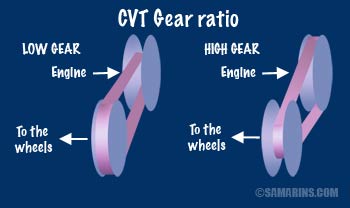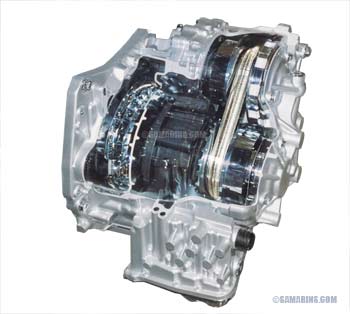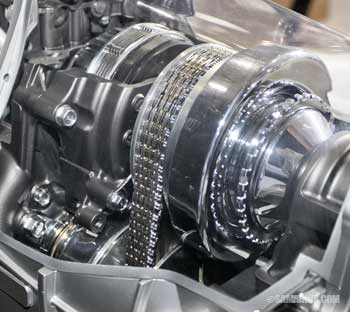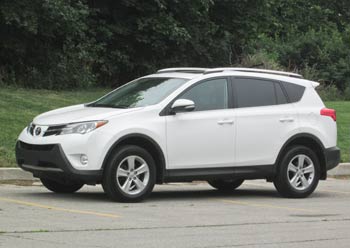Pros and cons of the CVT transmission
Updated: December 21, 2022
Many modern cars use a continuously variable transmission or CVT for better fuel economy. The CVT technology is clever and simple, but has its drawbacks. Let's look at the pros and cons and see how the CVT works. Here, we are only talking about the mechanical CVT with a variator; the electronic CVT used in hybrid vehicles is completely different and is not covered here.Pros:
- The CVT offers better fuel efficiency and lower emissions, especially in city driving for two reasons: First, the CVT shifts continuously and doesn't lose momentum during shifting. Second, the engine stays within the optimum RPM range longer.
- The engine is less strained because of the second reason mentioned above.
- The CVT takes up less space and is lighter than a similar conventional automatic transmission.
- The acceleration with the CVT is smoother and more linear.
- In many cars, if the CVT fails and is not covered by the warranty, it will be expensive to replace.
- The torque that the CVT can transfer is limited, which means that it's not the best choice for towing, sporty driving or extra load.
- The CVT is less beneficial if the vehicle is used for long highway commutes: First, the CVT fuel economy advantage is noticeable mostly in city driving. Second, the design of the CVT variatior is less suitable for long highway commutes, read more below.
How the CVT works:
The key component of the CVT is a variator. It consists of a chain or a steel belt running between two pulleys. Each pulley is made of two cones facing each other. The working surface of the cones is smooth. The size of each pulley can be changed by pushing the cones towards or away from each other using hydraulic pressure. The hydraulic pressure is generated by an oil pump.
When the drive pulley is smaller than the driven pulley, it equals to a low gear. When the size of the drive pulley is larger than that of the driven pulley, it equals to high gear. By continuously varying the size of the pulleys the CVT changes the gear ratio gradually.
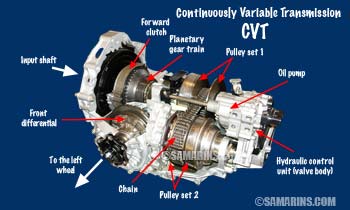 Audi Variable Automatic Gearbox (CVT) See the larger photo.
Audi Variable Automatic Gearbox (CVT) See the larger photo.Right now the cones of the pulley set 1 are pulled away from each other, while the cones of the pulley set 2 are squeezed together. This equals to the low (1-st) gear in a regular transmission.
As the vehicle accelerates, the transmission "upshifts" by gradually increasing the size of the pulley set 1 and reducing the size of the pulley set 2.
No, the maintenance requirements for CVT and conventional automatic transmission are basically the same; changing the transmission fluid in recommended intervals which is not very expensive.
Many manufacturers don't even list CVT fluid changes in the maintenance schedule for normal driving conditions. Instead, they advise changing the CVT fluid if the vehicle is operated in severe driving conditions, including towing, driving on dusty or muddy roads, or in freezing or very hot temperatures, etc.
Mechanics, however, advise changing the CVT fluid more often. We spoke to two mechanics who worked at a Nissan dealership and they recommended changing the CVT transmission fluid at least every 60,000 miles.
You can have your dealer check the CVT fluid condition and change it if needed. For example, the owner's manual for the 2017 Nissan Maxima says: ...request the dealer to inspect the fluid deterioration data using a CONSULT. If the deterioration data is more than 210000, replace the CVT fluid.
Fuel economy:
The main advantage of the CVT is better fuel economy, especially in city driving. A vehicle with a conventional automatic transmission loses some of the momentum while shifting from one gear into another. CVT has no fixed gears. It changes the gear ratio gradually without losing the momentum. It's also lighter and has fewer moving parts.
Torque:
One of the main drawbacks of the CVT is its limited torque capacity. Because the surfaces of the cones are smooth, the cones have to squeeze the belt or chain with great force. If an engine has too much torque, the belt or chain might slip. If the belt starts slipping in the CVT it will not last long.
Advertisement
Manufacturers are working on ways to increase the torque capacity of the CVTs, but for now it's still limited. This is why you don't see CVTs in pickup trucks and muscle cars, as their engines have much more torque.
Auto makers program the transmission control module or TCM of the CVT to keep it in the "lower gear" longer on acceleration. This reduces the load on the CVT belt and pulleys. That's why many reviewers often mention a louder engine noise and slower acceleration of the CVTs.
CVT replacement cost:
In some cars, the CVTs are expensive to replace. For example, in some Nissan or Subaru models replacing the CVT can cost upwards of $4,000. That said, replacing the CVT with a used unit in the tenth-generation Honda Civic, for example, is cheaper.
Is CVT better for long commutes or for city driving?
If you need a car for long commutes, a conventional automatic transmission or even a manual transmission are better in our view. When you are cruising at a steady speed in a car with a conventional automatic or a manual transmission, the torque is transferred through gears. Gears are better suited for extra torque and for extensive use; that's why many transport trucks have a manual transmission.
In a CVT, during long highway commutes, the torque is still transferred through the chain or belt and pulleys. What's more, when you drive steadily, the gear ratio doesn't change. This means that the chain or belt runs at the same area of the cones (pulleys) and over time can wear the surface of the cones (pulleys) in that area.
In our view, the CVTs are more suited for city driving. This is where the CVT is more fuel-efficient and smoother than a conventional automatic transmission.
How do you check if the CVT transmission is reliable in the vehicle you want to buy?
The number of CVT complaints varies not only between manufacturers, but even between different model years of the same car. For example, the quality of Nissan CVTs has not been consistent. We have seen some of the early Nissan Murano SUVs still going with over 200K, but some other models had problems. For example, according to CarComplaints.com, the 2013 model year saw a spike in CVT problems for Nissan Altima. Chrysler and Mitsubishi also had problems with their CVTs in some model years.
Subaru has extended the warranty for their CVTs for some models.
On the other hand, there are not that many complaints about the CVT in the 2014+ Toyota Corolla or 2016+ Honda Civic, for example.
Considering all that, the reliability of CVT transmissions should be judged on a case by case basis. Where can you check the reliability of a particular used car model?
ConsumerReports - to access their ratings online, you will need a paid subscription. You may also find a printed copy of their car buying guide in the book store or local library.
NHTSA Recalls - check for recalls for the vehicle you want to buy and click on "Complaints". If you compare the number of complaints from one model year to another, or between different cars, it's easy to see which model years and which cars should be avoided. You can find transmission complaints under "Powertrain."
CarComplaints.com - you can also see the model years to avoid.
Another lifehack is to check the vehicle's trade-in value. What will it tell you? Car dealers know which cars have expensive problems and set the trade-in value accordingly. Check the trade-in value at KBB.com and if it's very low compared to other similar cars, you know the car should be avoided.
Is there a way to extend the life of a CVT?
Many CVT transmission problems are caused by overheating. For this reason, many automotive enthusiasts recommend changing the CVT fluid more often and installing an additional or a heavy-duty CVT fluid cooler to keep the CVT fluid from overheating. This is even more important if you like spirited driving or use your car for towing. There are many YouTube videos on this subject.
Read Next:
Buying a Used Car: 10 Common Mistakes to Avoid
Signs of automatic transmission problems when test driving a used car
Pros and cons of turbo engines
Pros and Cons of a Manual Transmission
Pros and cons of buying a car with Direct Injection
What mileage is OK for a used car?
How to inspect a used car - illustrated guide
How to check an engine when buying a used car
Buying a Used Car: 10 Common Mistakes to Avoid
Signs of automatic transmission problems when test driving a used car
Pros and cons of turbo engines
Pros and Cons of a Manual Transmission
Pros and cons of buying a car with Direct Injection
What mileage is OK for a used car?
How to inspect a used car - illustrated guide
How to check an engine when buying a used car
